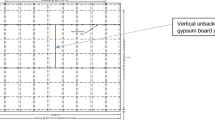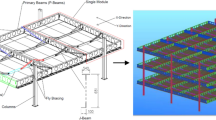Abstract
Load-bearing Light Gauge Steel Frame (LSF) walls are made of cold-formed steel frames and lined with fire-resistant gypsum plasterboards, and include cavity insulation based on energy performance requirements. Despite the importance of their fire performance, the current fire design methods rely mostly on a prescriptive approach, which relies on fire resistance ratings (FRR) provided by the wall manufacturers due to the lack of knowledge of the various parameters affecting the fire performance of LSF walls. This paper identifies the parameters affecting the fire performance of LSF walls, and presents a detailed review of the fire performance of LSF walls as a function of these parameters, based on recent research studies. It discusses the effects of elevated temperature thermal properties, plasterboard fall-off, cavity insulation, wall configuration, and stud section shapes on the thermal performance of LSF walls, and presents a detailed study of the temperature distribution patterns across the stud cross-sections. Negative effects of plasterboard joints are also demonstrated using fire test results. Elevated temperature mechanical properties of steel, time–temperature profiles of walls, stud section shapes and their sizes were found to be affecting the structural performance of LSF walls in fire, and their effects are discussed. The importance of using accurate elevated temperature mechanical properties in determining the FRR of LSF walls is also demonstrated. A good understanding of the identified parameters on the fire performance of LSF walls can lead to the use of a performance-based fire design method, and development of LSF walls with enhanced fire performance.



















Similar content being viewed by others
References
Gunalan S, Kolarkar PN, Mahendran M (2013) Experimental study of load bearing cold-formed steel wall systems under fire conditions. Thin Walled Struct 65:72–92
Kesawan S, Mahendran, M (2015) Fire tests of load-bearing LSF walls made of hollow flange channel sections. J Constr Steel Res 155:191–205
Kodur VKR, Sultan MA (2006) Factors influencing fire resistance of load-bearing steel stud walls. Fire Technol 42:5–26
Kolarkar PN, Mahendran M (2008) Thermal performance of plasterboard lined steel stud walls. In: Proceedings of the 19th international specialty conference on cold formed steel structures 2008, St. Louis, Missouri, USA, pp 517–530
Sultan MA (1996) A model for predicting the heat transfer through non-insulated unloaded steel-stud gypsum board wall assemblies exposed to fire. National Research Council Canada, Ottawa
Sultan MA (2015) Effect of gypsum board orientation on board fall-off in fire resistance test assemblies. In: Wessel R, Shipp P, Rosenthal G (eds) Advances in gypsum technologies and building systems, STP158820150013. ASTM International, West Conshohocken, pp 10–29
Samuel LM, Suel-Hyun P, Tensei M, Dale PB (2008) Measurement of thermal properties of gypsum board at elevated temperatures. In: Proceedings of the fifth international conference on structures in fire (SiF’08), pp 656–665
Gerlich JT (1995) Design of loadbearing light steel frame walls for fire resistance. Fire Engineering Research Report 95/3, University of Canterbury, Christchurch, New Zealand
Wakili KG, Hugi E, Wullschleger L, Frank TH (2007) Gypsum board in fire-modelling and experimental validation. J Fire Sci 25:267–282
Thomas GC (2010) Modelling thermal performance of gypsum plasterboard lined light timber frame walls using SAFIR and TASEF. Fire Mater 34:385–406
Keerthan P, Mahendran M (2012) Numerical studies of gypsum plasterboards under fire conditions. Fire Saf J 53:105–119
Keerthan P, Mahendran M (2012) Numerical modelling of non-load bearing light gauge cold-formed steel frame walls under fire conditions. J Fire Sci 30:375–403
Franssen JM, (SAFIR) (2005) A thermal/structural program modelling structures under fire. Eng J 42:143–158
Feng M, Wang YC, Davies JM (2003) Thermal performance of cold-formed thin-walled steel panel systems in fire. Fire Saf J 38:365–394
Thomas GC (2002) Thermal properties of gypsum plasterboard at high temperatures. Fire Mater 26:37–45
Keerthan P, Mahendran M (2013) Thermal performance of load-bearing cold-formed steel walls under fire conditions using numerical studies. J Struct Fire Eng 5(3):261–289
Hopkin DJ, Lennon T, El-Rimawi J, Silberschmidt VV (2012) A numerical study of gypsum plasterboard behaviour under standard and natural fire conditions. Fire Mater 36(2):107–126. doi:10.1002/fam.1092
Kontogeorgos DA, Mandilaras ID, Founti MA (2011) Scrutinizing gypsum board thermal performance at dehydration temperatures. J Fire Sci 29:111–130. doi:10.1177/0734904110381731
Kontogeorgos DA, Founti MA (2012) Gypsum board reaction kinetics at elevated temperatures. Thermochim Acta 529:6–13. doi:10.1016/j.tca.2011.11.014
Kontogeorgos DA, Founti MA (2012) Gypsum board dehydration kinetics at autogenous water vapour partial pressure. Thermochim Acta 545:141–147. doi:10.1016/j.tca.2012.07.009
Kontogeorgos DA, Mandilaras ID, Founti MA (2014) Fire behaviour of regular and latent heat storage gypsum boards. Fire Mater. doi:10.1002/fam.2246
Georgios KS, Mandilaras ID, Kontogeorgos DA, Founti MA (2016) Simplified correlations of gypsum board thermal properties for simulation tools. Fire Mater 40(2):229–245. doi:10.1002/fam.2282
Keerthan P, Mahendran M, Frost RL (2013) Fire safety of steel wall systems using enhanced plasterboards. In: Proceedings of the 19th international CIB world building congress 2013, Brisbane, Australia, pp 1–12
Baux C, Mélinge Y, Lanos C (2008) Enhanced gypsum panels for fire protection. J Mater Civil Eng 20:71–77
Baspinar M, Kahraman E (2011) Modifications in the properties of gypsum construction element via addition of expanded macroporous silica granules. Constr Build Mater 25:3327–3333
Buchanan AH, Gerlich JT (1997) Fire performance of gypsum plasterboard. In: Proceedings of the IPENZ annual conference, Wellington Institution of Professional Engineers, New Zealand
Alfawakhiri F, Sultan MA, MacKinnon DH (1999) Fire resistance of load-bearing steel-stud walls protected with gypsum board. J Fire Technol 35:308–335
Kesawan S, Mahendran M (2016) Thermal performance of load-bearing walls made of cold-formed hollow flange channel sections in fire. Fire Mater 40(5):704–730
Feng M, Wang YC, Davies JM (2003) Axial strength of cold-formed thin-walled steel channels under non-uniform temperatures in fire. Fire Saf J 38:679–707
Zhao B, Kruppa J, Renaud C, O’Connor M, Mecozzi E, Apiazu W, Demarco T, Karlstrom P, Jumppanen U, Kaitila O, Oksanen T, Salmi P (2005) Calculation rules of lightweight steel sections in fire situations. Technical steel research, European Union
Shahbazian A, Wang YC (2011) Application of the direct strength method to local buckling resistance of thin-walled steel members with non-uniform elevated temperatures under axial compression. Thin Walled Struct 49(12):1573–1583
Baleshan B, Mahendran M (2016) Fire design rules to predict the moment capacities of thin-walled floor joists subject to non-uniform temperature distributions. Thin Walled Struct 105:29–43
Baleshan B, Mahendran M (2016) Numerical study of high strength LSF floor systems in fire. Thin Walled Struct 101:85–99
Alfawakhiri F (2001) Behaviour of cold-formed-steel-framed walls and floors in standard fire resistance tests. PhD Thesis, Department of Civil and Environmental Engineering, Carleton University, Ottawa, Ontario, Canada
Feng M, Wang YC (2005) An experimental study of loaded full-scale cold-formed thin-walled steel structural panels under fire conditions. Fire Saf J 40:43–63
Gunalan S, Mahendran M (2013) Finite element modelling of load bearing cold-formed steel wall systems under fire conditions. Eng Struct 56:1007–1027
Ariyanayagam AD, Mahendran M (2014) Numerical modelling of load bearing light gauge steel frame wall systems exposed to realistic design fires. Thin Walled Struct 78:148–170
Kesawan S, Mahendran M (2015) Predicting the performance of LSF walls made of hollow flange sections in fire. Thin Walled Struct 98(A):111–126
Jatheeshan V, Mahendran M (2015) Experimental study of LSF floors made of hollow flange channel section joists under fire conditions. J Struct Eng ASCE 142(2):04015134. doi:10.1061/(ASCE)ST.1943-541X.0001409
Jatheeshan V, Mahendran M (2015) Numerical study of LSF floors made of hollow flange channels in fire. J Constr Steel Res 115:236–251
Jatheeshan V, Mahendran M (2016) Fire design of LSF floors using hollow flange channel joists. J Constr Steel Res 125:263–78
Kesawan S, Mahendran M. 2017, Fire performance of LSF walls made of hollow flange channel studs. J Struct Fire Eng 8(2):149–180. doi:10.1108/JSFE-03-2017-0027
Ariyanayagam AD, Mahendran M (2014) Experimental study of load-bearing cold-formed steel walls exposed to realistic design fires. J Struct Fire Eng 5(4):291–330
Cooke GME (1988) Thermal bowing and how it affects the design of fire separating construction. Fire Research Station, Building Research Establishment, Herts
Gunalan S, Mahendran M (2014) Fire performance of cold-formed steel wall panels and prediction of their fire resistance rating. Fire Saf J 64:61–80
Dolamune Kankanamge N, Mahendran M (2011) Mechanical properties of cold-formed steels at elevated temperatures. Thin Walled Struct 49:26–44
Klippstein KH (1980) Strength of cold-formed studs exposed to fire. American Iron and Steel Institute, Washington
Kesawan S, Jatheeshan V, Mahendran, M (2015) Elevated temperature mechanical properties of hollow flange channel sections. J Constr Build Mater 87:86–99
Outinen J, Makelainen P (2002) Mechanical properties of structural steels at elevated temperatures and after cooling down. Second International Workshop, Christchurch, pp 273–289
Wei C, Jihong Y (2012) Mechanical properties of G550 cold-formed steel under transient and steady state condition. J Constr Steel Res 73:1–11
EN 1993-1-2 (2005) Eurocode 3: design of steel structures, part 1-2: general rules—structural fire design, European Committee for Standardization, Brussels
Kesawan S, Mahendran M (2016) Fire design rules for LSF walls made of hollow flange channel sections. Thin Walled Struct 107:300–314. doi:10.1016/j.tws.2016.05.022
Standards Australia (SA) (2005) Methods for fire tests on building materials, components and structures. Fire-resistance tests of elements of building construction, Sydney, AS 1530.4, Australia
Acknowledgements
The authors would like to thank QUT for providing the full scale fire testing and high performance computing facilities, and QUT and Australian Research Council for providing financial support to conduct this research project.
Author information
Authors and Affiliations
Corresponding author
Rights and permissions
About this article
Cite this article
Kesawan, S., Mahendran, M. A Review of Parameters Influencing the Fire Performance of Light Gauge Steel Frame Walls. Fire Technol 54, 3–35 (2018). https://doi.org/10.1007/s10694-017-0669-8
Received:
Accepted:
Published:
Issue Date:
DOI: https://doi.org/10.1007/s10694-017-0669-8




